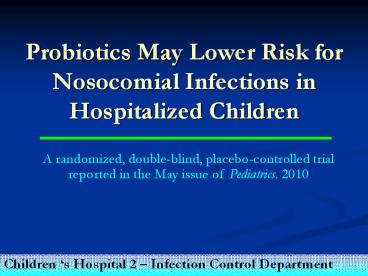Probiotics May Lower Risk for Nosocomial Infections in Hospitalized Children - PowerPoint PPT Presentation
Title:
Probiotics May Lower Risk for Nosocomial Infections in Hospitalized Children
Description:
Probiotics May Lower Risk for Nosocomial Infections in Hospitalized Children A randomized, double-blind, placebo-controlled trial reported in the May issue of ... – PowerPoint PPT presentation
Number of Views:147
Avg rating:3.0/5.0
Title: Probiotics May Lower Risk for Nosocomial Infections in Hospitalized Children
1
Probiotics May Lower Risk for Nosocomial
Infections in Hospitalized Children
A randomized, double-blind, placebo-controlled
trial reported in the May issue of Pediatrics.
2010
Children s Hospital 2 Infection Control
Department
2
BACKGROUNDS
- The incidence of nosocomial infections,
predominantly gastrointestinal and respiratory,
in children in developed countries is high,
ranging from 5 to 44. - Gastrointestinal infections (4.522.6 episodes
per 100 admissions) and respiratory infections
(incidence ranging from 13 to 53 in all
hospitalized children) account for the
predominant types of infections.
3
BACKGROUNDS
- One of the potential strategies for the
prevention of nosocomial infections is the use of
probiotics. - ?The objective of this study was to investigate
the role of Lactobacillus GG (LGG) in preventing
nosocomial gastrointestinal and respiratory tract
infections at a pediatric hospital.
4
METHODS
- The study design was a prospective, randomized,
double-blind, placebo-controlled trial. - 742 children, aged 1 to 18 years, were randomly
assigned to receive LGG (n 376) or placebo (n
366) during their hospitalization at Pediatric
Department (Children's Hospital Zagreb, Zagreb,
Croatia) from November 2007 to May 2008.
5
METHODS
- LGG was given at a dose of 109 colony-forming
units in 100 mL of a fermented milk product, and
the placebo consisted of the same postpasteurized
fermented milk product without LGG. - The LGG product and placebo were packed in
identical bottles they were of the same color,
weight, smell, and taste.
6
METHODS
- During the test period, patients were not allowed
to consume any other product that contained
probiotics or prebiotics. - All gastrointestinal and respiratory tract
infections were diagnosed by a pediatrician.
7
RESULTS
- The risk for gastrointestinal infections was
significantly reduced in the LGG group compared
with the placebo group (RR 0.40 95 CI 0.25
0.70 NNT 15 95 CI 934). - Similarly, the risk for respiratory tract
infections was significantly reduced in the LGG
group compared with the placebo group (RR 0.38
95 CI 0.180.85 NNT 30 95 CI 16159).
8
RESULTS
- Moreover, in gastrointestinal infections
patients, they compared the LGG group with the
placebo group, children in the LGG group had a
reduced risk for vomiting episodes (RR 0.5 95
CI 0.30.9) and diarrheal episodes (RR 0.24
95 CI 0.100.50.
9
RESULTS
- None of the gastrointestinal infection patients
had a bacterial infection. - In 5 patients, rotavirus (2 patients both in the
placebo group) or norovirus (3 patients 2 in the
placebo group and 1 in the LGG group) was
isolated. All patients were treated
symptomatically, and none required antibiotic
treatment.
10
RESULTS
- In regard to respiratory tract infections,
patients in the LGG group had a lower risk for
episodes of respiratory tract infections that
lasted gt3 days than patients in the placebo group
(RR 0.4 95 CI 0.20.9 NNT 33 95 CI
17257)
11
RESULTS
- All patients had upper respiratory tract
infections, and only 1 patient in the placebo
group also had a diagnosis of pneumonia. - A bacterial cause was determined and treated with
antibiotics in only 5 patients with upper
respiratory tract infections (4 were from the
placebo group).
12
CONCLUSIONS
- The results of the randomized, double-blind,
placebo-controlled trial suggests that
Lactobacillus GG administration decreases the
risk for nosocomial gastrointestinal and
respiratory tract infections in hospitalized
children. - ? LGG administration can be recommended as a
valid measure for decreasing the risk for
nosocomial gastrointestinal and respiratory tract
infections in pediatric facilities.
13
CONCLUSIONS
- However, they suggest that this may not be
justified in all hospitalized children because of
the relatively high NNT (15 for gastrointestinal
tract infections and 30 for respiratory tract
infections).
14
CONCLUSIONS
- Limitations of the study include exclusion of
infants younger than 1 year, and short duration
and unproven cause of most of the nosocomial
infections diagnosed during the study. - ? They encourage future studies of children who
are younger than 12 months.
15
THANK YOU































